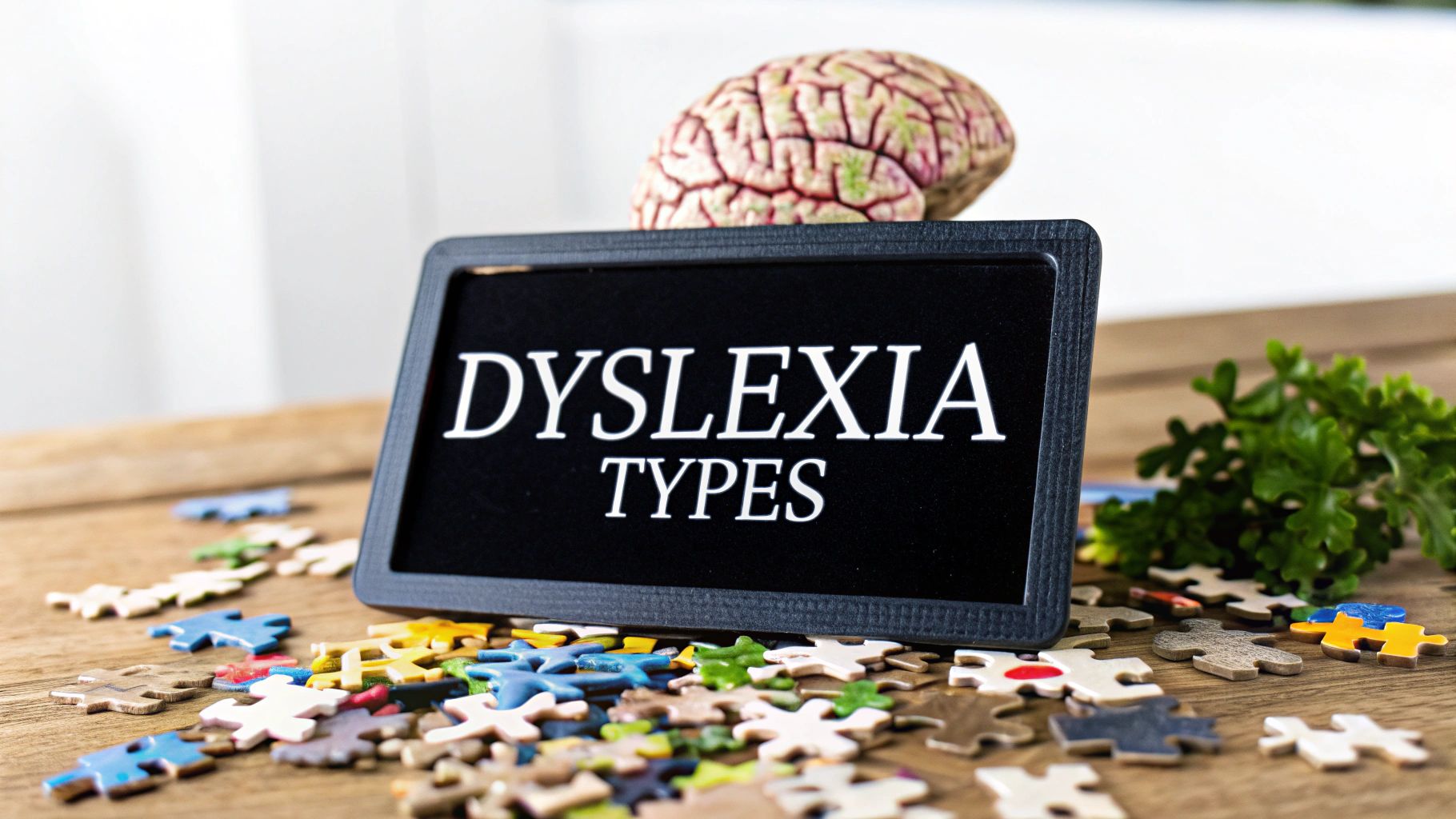If you've landed here, it’s probably because you’re trying to make sense of your child's world, feeling that mix of worry and determination that comes with seeing them struggle. This guide is designed to move beyond the single label of 'dyslexia' to explore the different types, helping you pinpoint exactly where the struggle might lie. Knowing what to look for is the most powerful first step you can take on this journey together.
Your Child's Unique Brain: How Dyslexia Varies
Let's start by thinking about dyslexia not as a simple roadblock, but as a different kind of brain wiring—one that comes with its own unique strengths and very specific challenges. It’s a deeply emotional journey for any parent watching their child get frustrated with a book, seeing their bright spark dim a little with every jumbled word. It can leave you feeling lost and aching to help. But clarity and confidence begin with understanding.
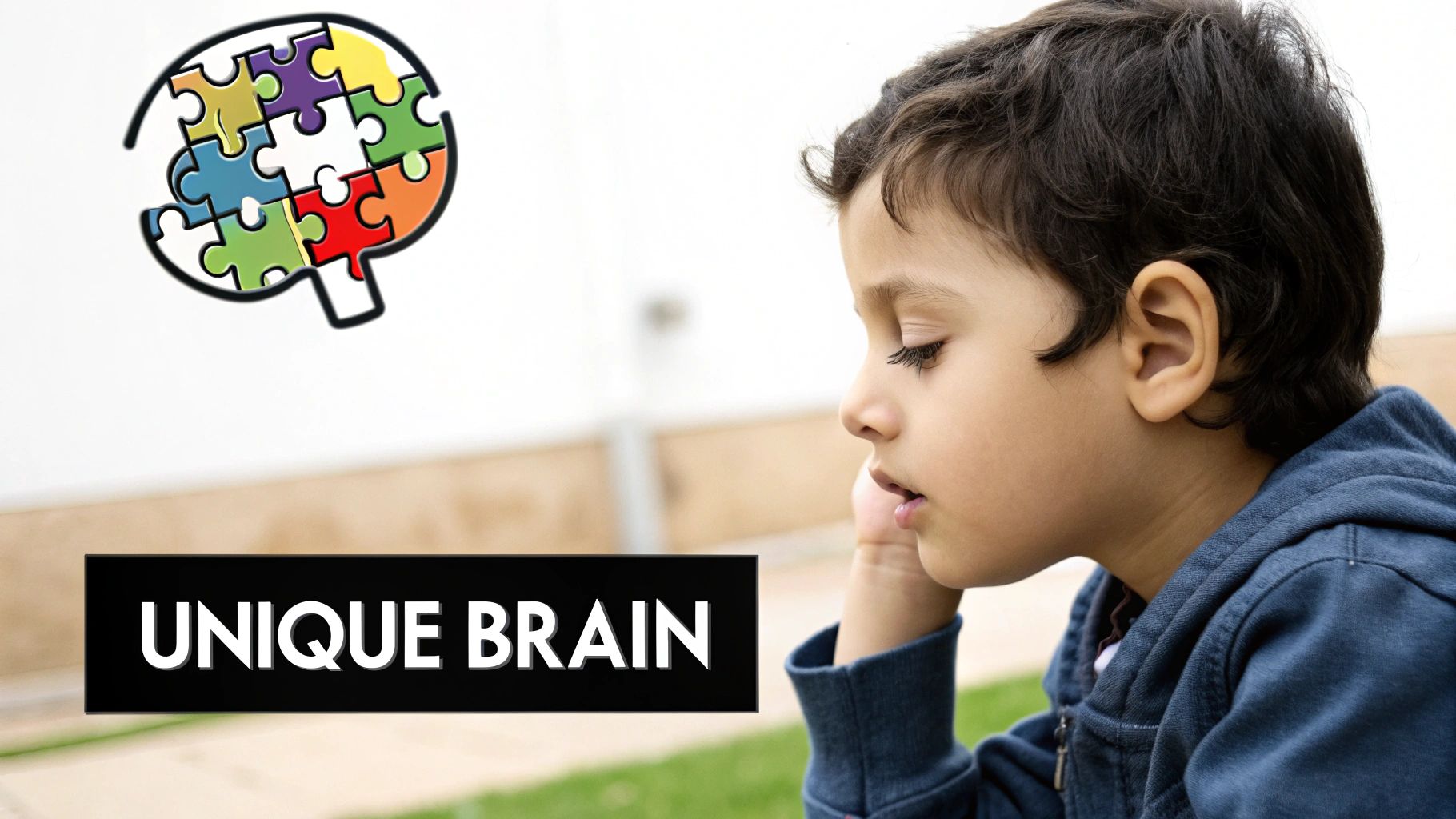
Dyslexia is widely recognised as the most common learning difficulty in the UK, affecting around 10% of the population. That means in almost every classroom, there are children whose brains process language in a non-typical way. This simple fact highlights just how vital patient, informed, and tailored support really is for each and every one of them.
Moving Beyond a Single Label
Thinking about the different types of dyslexia is so important because no two children experience it in the same way. The label itself doesn't tell you how your child struggles, or more importantly, how you can help.
- One child might look at the letters 'p-a-t' and find it incredibly difficult to connect them to the sounds they make. This is a phonological challenge. You might see them get upset during phonics homework, feeling like everyone else gets a secret code they don't.
- Another child might be able to sound out words but stumbles over and over on common sight words like 'was' or 'friend'—a surface challenge. It’s heartbreaking to see them read a word perfectly in one sentence and then not recognise it in the next, as if they're seeing it for the first time.
Understanding whether their difficulty is with sounds or sight words transforms confusion into clarity. It empowers you to provide the targeted, compassionate support that builds confidence and reminds them how capable they truly are.
For parents trying to get a better handle on their child's unique way of thinking, reading a counsellor's perspective on neurodiversity and diagnosis can offer invaluable reassurance and insight. When you can recognise these specific patterns, you can start using approaches that genuinely meet your child where they are, respecting their emotional needs.
This is where strategies like differentiated learning come into their own, allowing educators to adapt their teaching to fit a child’s individual learning profile. You can learn more about how this kind of personalised teaching helps children thrive by exploring our guide on what differentiated learning is. By identifying the specific type of dyslexia, you can begin a focused, effective, and much less stressful path forward for you and your child.
A Quick Guide to the Types of Dyslexia
To truly support your child, it helps to understand the specific path their brain takes when it tries to process words. Thinking about the different types of dyslexia isn’t about fitting them into a rigid box; it's about finding the right key to unlock their learning potential and ease their daily frustration.
For some children, the main struggle is linking letters to their sounds, making every new word a frustrating puzzle. For others, sounding out words is surprisingly easy, but they just can't seem to remember common words like 'the' or 'friend' by sight, which can make them feel like their memory is failing them. These subtle differences matter enormously to their confidence and progress.
This initial overview provides a simple map of the dyslexia landscape, helping you start to notice your child’s specific patterns and strengths. Dyslexia isn’t a single, one-size-fits-all condition. Instead, it includes several types, each with its own core challenges. In the UK, these distinctions help shape the targeted interventions used in schools, where around 10% of children are identified with dyslexic traits. For a broader look at how these are categorised, you can explore this in-depth overview of learning disabilities.
The infographic below illustrates the main branches of dyslexia, showing how they stem from different root challenges in the brain.
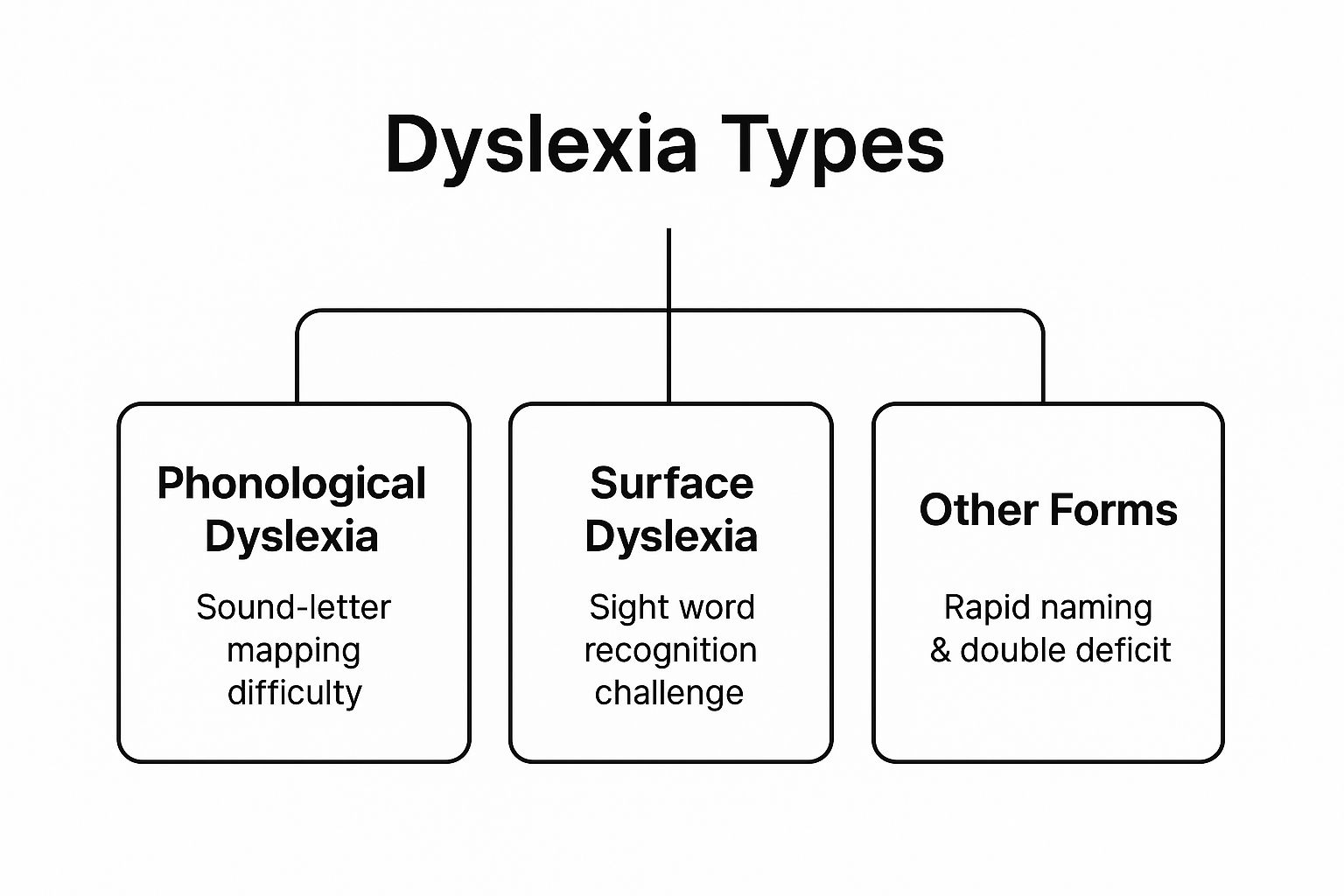
As you can see, the most common forms relate to either sound-letter mapping or sight word recognition, while other types involve how quickly the brain processes information.
To help you get a clearer picture, this quick-reference table breaks down the main types of dyslexia, what they look like in everyday life, and where to focus your support.
Quick Guide to the Different Types of Dyslexia
| Type of Dyslexia | Core Challenge | What You Might See at Home | Best Support Focus |
|---|---|---|---|
| Phonological Dyslexia | Connecting sounds to letters (phonemes). | Gets frustrated trying to sound out new words, struggles with rhyming games, spelling seems random (e.g., 'fon' for 'phone'). | Multisensory phonics programmes (like tracing letters in sand while saying the sound) that build strong sound-symbol links. |
| Surface Dyslexia | Recognising whole words by sight. | Reading is slow and tiring, even with familiar books. Tries to sound out irregular words like 'yacht' or 'island'. | Fun activities to build sight vocabulary, like playing 'snap' with flashcards or creating a personal 'word wall' in their room. |
| Rapid Naming Dyslexia | Quickly naming familiar objects, colours, or letters. | Pauses for a long time when asked to name letters in a row. Reading is slow and choppy, losing the meaning of the sentence. | Gentle, playful timed drills and games (like 'I Spy' with letter sounds) that improve processing speed and automatic recognition. |
| Double Deficit Dyslexia | A combination of phonological and rapid naming difficulties. | Significant challenges with both decoding words and reading fluently, leading to high levels of frustration. | A gentle, integrated approach that addresses both phonics and reading speed, with lots of encouragement. |
This table is just a starting point. Often, a child might show signs of more than one type, but identifying their main area of difficulty is the first step toward getting them the right kind of help, tailored to their needs.
Understanding the Main Categories
Let's break down the two types you're most likely to hear about. Recognising these patterns in your child's reading is a huge step toward finding strategies that actually work for them and reduce their anxiety.
-
Phonological Dyslexia: This is the one most people think of when they hear 'dyslexia'. The core issue is with phonological awareness—the ability to hear and manipulate the individual sounds (or phonemes) in spoken words. A child with this type finds it incredibly difficult to connect those sounds to the letters on the page. For them, a simple rhyming game isn't fun; it's a confusing, stressful task. You might see them labouring over sounding out a simple word like 'cat' as if it's a monumental puzzle.
-
Surface Dyslexia: With this type, a child might actually be quite good at sounding out words phonetically. The real problem is with visual recognition of whole words. Their brain struggles to store and retrieve words as complete pictures, making reading slow and exhausting. This is especially true for those tricky, irregularly spelled English words like 'enough' or 'island'. It's heartbreaking to watch them sound out a word correctly, only to see it again two lines later and have no memory of it, forcing them to start the painful decoding process all over again.
At the heart of it all, identifying these differences is about empathy. It's about seeing the enormous effort your child is putting in and giving them the right tools for their specific struggle, turning frustration into progress and tears into confidence.
Phonological Dyslexia: The Sound and Letter Puzzle
Imagine trying to read a word for the first time, but the letters on the page feel like a secret code. You see ‘c-a-t’, but your brain just can’t seem to connect those shapes to the sounds /k/, /æ/, and /t/. This is the daily reality for a child with phonological dyslexia, which is the most common of the different types of dyslexia. It's not just a learning challenge; it's a constant source of anxiety.
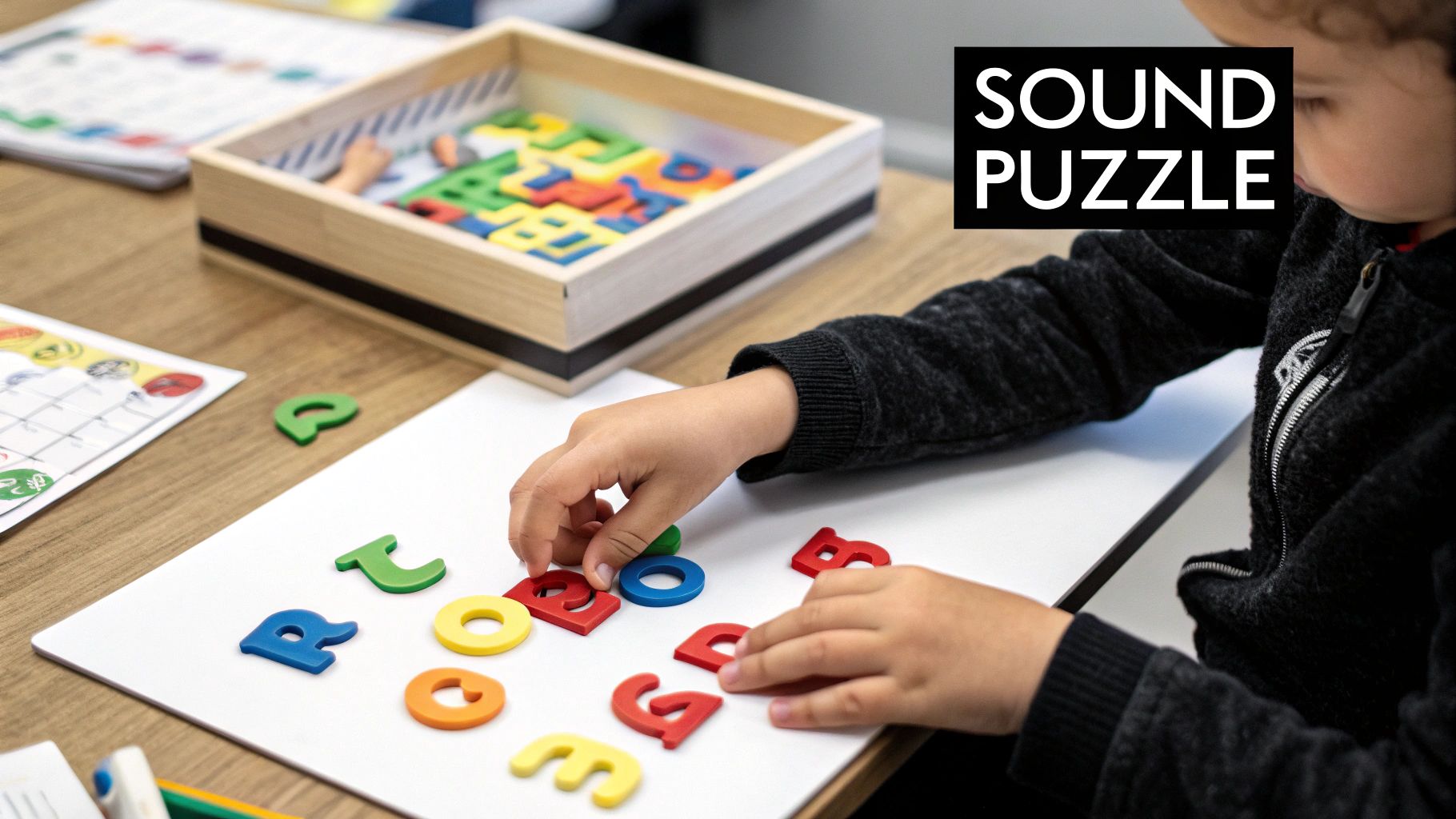
This isn’t about hearing. The challenge lies in something called phonological awareness—the ability to hear, identify, and play with the individual sounds, or phonemes, in spoken words. For a child with this type of dyslexia, breaking a word down into its sound parts is like trying to solve a puzzle with all the wrong pieces. It can be incredibly frustrating.
This constant struggle can take a heavy emotional toll. A child might feel embarrassed reading aloud in class, believing they aren't as clever as their peers. You might see them avoid homework, shut down when it’s time to read, or even say they feel 'stupid'—words that break a parent's heart. The truth is, their brain just needs a different, more patient way to learn.
What Phonological Dyslexia Looks Like at Home
Recognising the signs is the first step toward giving your child the compassionate and effective support they need. It’s important to remember they aren’t being difficult; they are working incredibly hard to make sense of a world where sounds and symbols don’t naturally connect for them.
You might notice they have trouble with:
- Rhyming: Word games with 'cat', 'hat', and 'mat' might be more confusing than fun, and they may look anxious when asked to join in.
- Sounding Out New Words: They may guess at words based on the first letter rather than trying to decode them, just to get through the sentence faster. For example, reading 'horse' as 'house'.
- Spelling: Their spelling often looks phonetic but is incorrect, like writing 'fone' for 'phone' or 'sed' for 'said'.
- Remembering Sequences: Recalling the alphabet, days of the week, or months of the year can be a real challenge, making them feel like they are always one step behind.
At its core, phonological dyslexia is a disconnect between the visual (the letter) and the auditory (the sound). The goal of support is to build a strong, reliable bridge between the two, turning confusion into confidence, one small victory at a time.
Building Bridges with Multi-Sensory Support
The key is to make learning sounds feel like a playful, physical game rather than a chore. Engaging multiple senses helps forge stronger connections in the brain, making abstract sound-letter relationships more concrete and memorable for your child.
Here are a few practical, child-centred ideas to get you started:
- Tactile Letters: Use magnetic letters, sandpaper letters, or even draw letters in a tray of sand or shaving foam. Let your child trace the shape of a letter while saying its sound aloud. Feeling the shape helps to anchor the sound in their memory.
- Syllable Clapping: Break down longer words into smaller, manageable chunks by clapping out the syllables. This turns an intimidating word like 'butterfly' into a fun, rhythmic game ('but-ter-fly').
- Sound Sorting Games: Gather small toys and sort them into boxes based on their beginning sound. Putting a ball, a block, and a boat into the 'B' box reinforces the /b/ sound in a tangible, hands-on way that feels like play, not work.
These gentle, multi-sensory strategies put your child's needs first, building their skills without damaging their self-esteem. As they strengthen these foundational skills, it’s also important to help them improve their overall reading ability. For more practical guidance, explore our tips on how to improve reading comprehension to support them on the next step of their journey.
Surface Dyslexia: When Familiar Words Seem New
Does your child read the word ‘have’ to rhyme with ‘gave’, or try to sound out ‘yacht’ as ‘y-atch’? These moments can be baffling and frustrating for both of you, especially when they seem to have a good grasp of phonics. This is often the first glimpse parents get of surface dyslexia, a unique challenge among the different types of dyslexia.
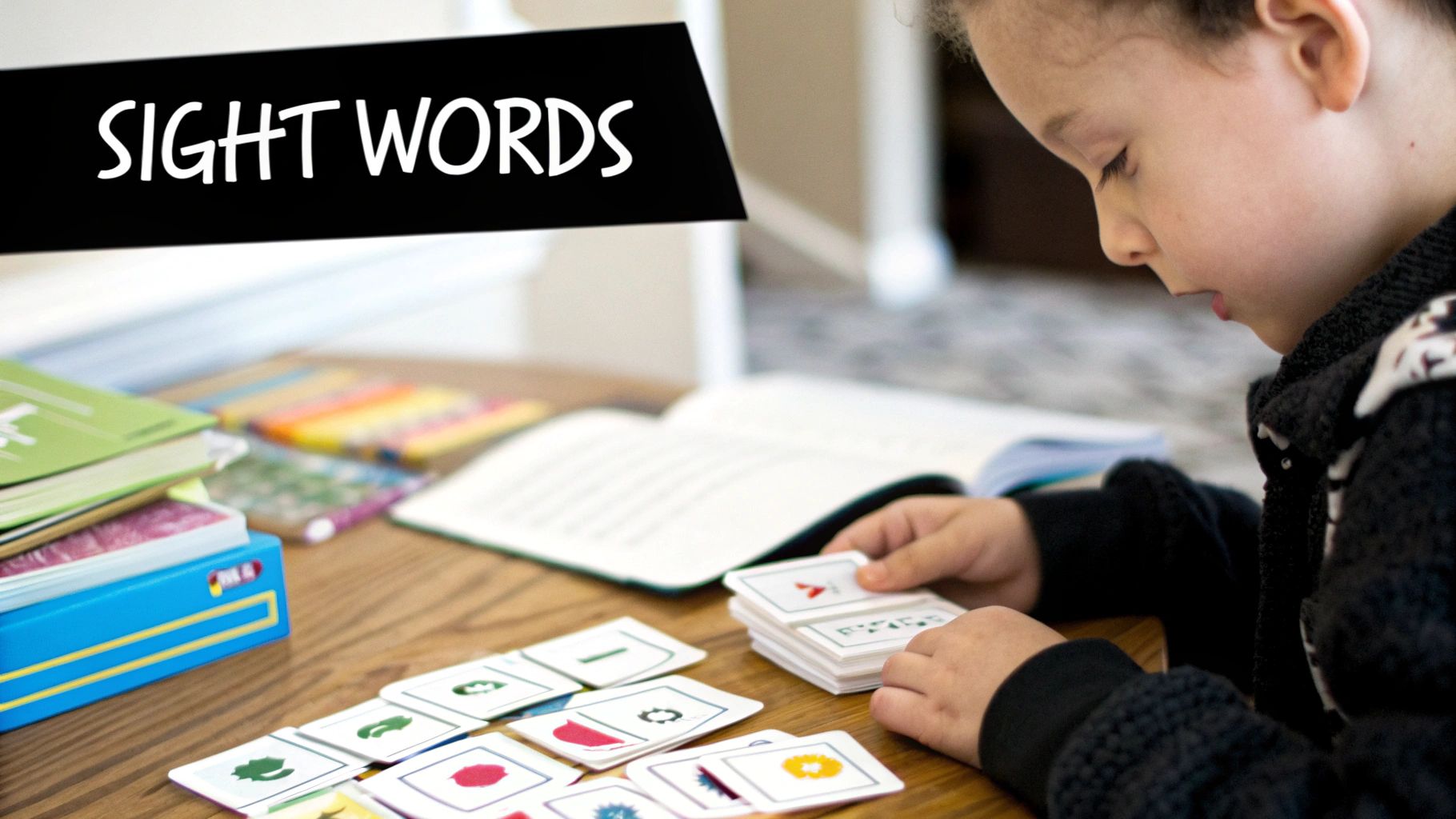
Unlike phonological dyslexia, the difficulty here isn't connecting letters to sounds. In fact, a child with surface dyslexia might be excellent at sounding out new, phonetically regular words. The real struggle is with instantly recognising familiar words by sight—especially those tricky words with irregular spellings that defy the rules.
Imagine your brain’s memory for words is like a photo album. For most of us, common words like ‘the’, ‘was’, or ‘friend’ have their own picture, which we recognise instantly. For a child with surface dyslexia, it’s as if that album is nearly empty. Each time they see a word, their brain tries to decode it from scratch, even if they just read it two sentences ago.
The Emotional Effort of Constant Decoding
This constant need to sound everything out is mentally exhausting. Think of the frustration of having to decode your own name every single time you saw it written down. This is the kind of mental load your child might be carrying with every page they turn. It can make reading feel like an endless battle, leading to avoidance, anxiety, and a painful belief that they are simply ‘bad’ at it.
You might notice them reading slowly and deliberately, often mispronouncing common words that don't follow the rules. This isn't a lack of effort; it's a sign of a brain working overtime to apply phonetic logic to a language that frequently breaks its own rules. It takes immense courage for them to keep trying.
For a child with surface dyslexia, every word is a new puzzle. Our goal isn’t just to teach them to solve the puzzle faster, but to help them build a library of 'word photos' they can recognise in an instant, giving their hardworking brain a much-needed rest.
Practical Ways to Build a Sight Word Library
Supporting a child with surface dyslexia means shifting the focus from phonics to visual recognition and memory. The aim is to help them build that internal photo album of words, making reading smoother and far less tiring. The best strategies feel like games, not tests, keeping their emotional well-being at the centre of every step.
Here are some gentle, practical approaches you can try at home:
- Create a Personal Word Bank: Use flashcards to create a set of 'word photos' for high-frequency or tricky words. Instead of drilling them, play quick, fun matching games like Snap or go on a 'word hunt' in a favourite book to find their special words.
- Use Stories with Repetitive Phrases: Books with predictable, repeating sentences are fantastic. Each time your child sees the same phrase—like "I do not like green eggs and ham"—it reinforces the visual memory of those words in a meaningful, low-pressure context.
- Highlight the Tricky Bits: For irregular words like ‘enough’, use a different coloured pen to highlight the tricky part (‘ough’). This helps their brain pay special attention to the non-phonetic element and remember its unique shape, turning it into a visual landmark.
- Celebrate Persistence Over Perfection: Acknowledge their hard work out loud. Saying, "I saw how you worked so hard on that sentence, well done," values their effort and builds resilience, reminding them that their persistence is what truly matters.
Digging a Little Deeper: Other Forms of Dyslexia
So far, we’ve looked at dyslexia through the lenses of sounds and sight words. But that’s not the whole story. Sometimes, the real hurdle isn’t just decoding the words, but the sheer speed at which the brain can find and name what it already knows.
This is often one of the most confusing parts for parents. You see your child struggling to name a letter or a number, and you know, with absolute certainty, that they know it. It’s like their brain has the right file, but the search function is lagging. That moment of hesitation, that look of frustration on their face as they search for a word that's on the tip of their tongue, is heartbreaking.
This isn’t about knowledge. It’s all about automaticity—the ability to pull up information instantly, without conscious effort. When that process is slow, the mental energy needed just to get through a sentence goes through the roof, leaving them exhausted and defeated.
Rapid Naming Deficit
Imagine you lay out a row of familiar colours—blue, red, green, yellow—and ask your child to name them as fast as they can. A child with a Rapid Naming Deficit, also known as Rapid Automatised Naming (RAN) deficit, will absolutely know the colours. The problem is, they’ll struggle to say them quickly one after another, with painful pauses in between.
The same glitch happens with letters, numbers, and common objects. It’s not a memory problem; it’s a processing speed issue that slows down the retrieval of well-learned information. This makes reading incredibly choppy. Even if a child has solid phonics skills, the effort they burn just naming the letters on the page leaves very little brainpower for blending sounds and actually understanding what they're reading.
Double Deficit Dyslexia
For some children, the challenge is even greater, and it's a heavy burden for a small person to carry. Double Deficit Dyslexia is exactly what it sounds like—a child is grappling with two distinct difficulties at once:
- A Phonological Deficit: The classic difficulty with hearing, identifying, and working with sounds in spoken words.
- A Rapid Naming Deficit: The slow processing and retrieval speed we just talked about.
This combination creates a really significant barrier to reading fluently. The child is fighting a battle on two fronts: struggling to sound out individual words while also being unable to achieve the speed needed for smooth reading. It’s a profound challenge that can be deeply disheartening for a child who feels they’re working twice as hard as everyone else for half the result.
Realising your child might be facing a more complex profile is so important, because it means that a standard, one-size-fits-all approach just isn’t going to cut it. Their support plan needs to be far more carefully tailored to their specific, individual needs.
This is precisely where a professional assessment becomes invaluable. An educational psychologist can run specific tests to measure both phonological skills and rapid naming speed. Getting that clarity moves you from guesswork to a targeted strategy—one that is as unique as your child. It ensures that every ounce of their effort, and your support, is channelled exactly where it will make the most difference.
Your Action Plan for Supporting Your Child
Understanding the different types of dyslexia is the first, crucial step. But what comes next? This is where you shift from observer to advocate, paving a supportive path forward for your child. It all starts at home—with gentle observation and a commitment to celebrating everything they are, not just what they find difficult.
Your role is incredibly powerful. Begin by simply noticing and documenting the specific patterns you see. For example, you could note down: "Tonight, Leo read 'was' as 'saw' three times, and got really upset when he tried to sound out the word 'laughing'." These little details are gold dust when you start a conversation with their teacher.
Nurturing Their Spirit and Strengths
Before you take any formal steps, your first job is to protect their emotional well-being. Dyslexia can slowly chip away at a child's self-esteem, making them feel less capable than their friends. Your most important task is to build them back up.
- Celebrate their unique talents: Are they a gifted artist, a creative problem-solver, or wonderfully empathetic? Shine a massive spotlight on these strengths every single day. Make sure they know that their worth is not measured by how well they read.
- Reframe the narrative: Constantly reinforce the idea that dyslexia is just a different way of thinking and processing information. It is not a flaw or a sign of low intelligence. Talk about famous successful people with dyslexia, like Albert Einstein or Keira Knightley.
- Focus on effort, not just results: Praise their persistence when they wrestle with a tricky sentence. Saying something like, "That was a really tough word, and I'm so proud of you for not giving up," teaches them that their hard work is what truly counts.
Taking the Next Steps with Confidence
When you feel ready to look for more formal support, open a positive, collaborative conversation with your child's school. Share your observations and ask about their assessment process. A professional assessment is the key to truly understanding their specific learning profile and unlocking the right support.
Your goal is to make sure your child gets the tools they need to thrive. This often involves creating a personalised support structure at school, which will become a cornerstone of their academic journey.
This process can lead to targeted interventions that work with their brain, not against it. To get a clearer picture of what this might look like, you can find some very helpful Individualised Education Plan examples that show how tailored support is put into practice.
Remember, you are their biggest and most important advocate. Your love and belief in them is the foundation upon which all their future success will be built.
Frequently Asked Questions About Dyslexia Types
Navigating the world of dyslexia can feel overwhelming, and it’s only natural for questions to pop up along the way. Below, we’ve put together some clear, supportive answers to the concerns we hear most often from parents exploring the different types of dyslexia.
Can a Child Have More Than One Type of Dyslexia?
Yes, absolutely. In fact, it’s quite common for a child’s learning profile to show characteristics of more than one type of dyslexia. A classic example is something called ‘Double Deficit Dyslexia,’ which is a blend of phonological challenges (trouble processing sounds) and a rapid naming deficit (difficulty recalling letters and numbers quickly).
This overlap is precisely why a professional assessment is so vital. It’s not about finding a single label; it's about building a complete picture of your child’s unique strengths and challenges. This allows for a support plan that addresses everything they need, not just one piece of the puzzle.
How Do I Know if This Is Dyslexia or Just a Developmental Delay?
This is one of the biggest worries for parents, and it’s a perfectly valid question. Children all develop at their own pace, but dyslexia involves a persistent pattern of difficulty that doesn’t seem to improve with standard classroom teaching.
While every child is different, here are a few practical examples that suggest something more than a simple delay might be going on:
- A five-year-old struggling with rhymes is typical; a seven-year-old who still finds it deeply confusing might be a sign.
- Having a hard time remembering the letters of the alphabet in the first year of school is common. Still struggling to recall them in order a year later is a stronger indicator.
- Mixing up letters like 'b' and 'd' is very normal for young children. If it's still happening consistently past the age of 7 or 8, it's worth looking into.
- You notice a clear gap between their bright, articulate speaking skills and their immense struggles with reading and writing.
If these challenges stick around and are causing your child frustration and anxiety, it’s a good signal to chat with their teacher and consider a formal assessment.
Will Getting a Diagnosis Label My Child?
Many parents feel anxious about this, but a diagnosis isn't a label—it's a key. It’s what unlocks the right kind of support and understanding for your child. It doesn't limit them; instead, it explains how they learn best so you, their teachers, and they themselves can work with their brain, not against it.
It can be a massive relief for a child to finally have a reason for their struggles. A diagnosis helps them understand they aren't 'lazy' or 'not trying hard enough.' For many children, hearing "You have dyslexia" is the first time they truly believe that their difficulties aren't their fault. It empowers everyone to shift from frustration to effective strategies that truly work.
This need for clarity doesn’t fade with age. Many adults live with undiagnosed learning differences, and for them, understanding their own cognitive profile can be life-changing. A comprehensive guide to an adult learning disability assessment is often the first step on that journey.
At Queens Online School, we create personalised learning paths that celebrate every child's unique way of thinking. Our specialist teachers provide the targeted support needed to help students with dyslexia build confidence and achieve their full potential. Discover our inclusive approach to online education.

